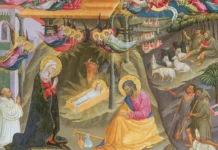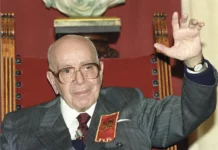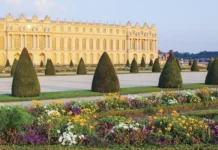We do not look back wistfully on a Catholic civilization of the past, but we turn with hope towards the Catholic era par excellence which is to come, the Reign of Mary. And, starting now, we can establish this reign within ourselves.
W hat is the foundation of Our Lady’s royalty? Why is She Queen? In what does this title consist?
First of all, we must consider that it befits a king to be the son of a queen. Now since Our Lord Jesus Christ is King of all men, both as God and as Man, the royalty of Our Lady results from the fact that She is the Mother of the King.
However, there is also another much deeper reason.
Desiring to be a slave, She became the Mother of God…
Since Adam’s sin, four thousand years of separation between God and man had elapsed, during which time it was not possible to enter Heaven. Souls remained in Limbo, waiting for the moment when Our Lord Jesus Christ would be born and redeem humanity. They waited for God to create that exceptional Virgin, endowed with unimaginable holiness and perfection, from whose womb the Saviour would be born.

Seeing the miserable state of mankind, the most Blessed Virgin Mary asked God to send the Saviour to earth in her day. She also longed to meet His Mother and to serve Her as a servant or slave. We can imagine the trembling of Our Lady’s soul when She learned, from the angelic greeting, that the chosen one was She herself. What must have been the virtuous, holy and yet joyous awe her soul experienced?
Let us fully comprehend the perfection of Our Lady’s reply to the Angel: “Behold, I am the handmaid of the Lord; let it be to me according to your word” (Lk 1:38). That is to say: “I thought I did not merit it, but since the invitation comes from God, let it be done to me according to your word.” At that moment, the Holy Spirit worked in the Blessed Virgin, and Our Lord Jesus Christ was conceived in her womb.
And so began the most beautiful period in which Jesus lived in Mary. During the entire gestation, She was the tabernacle within which Our Lord gave glory to the Eternal Father.
…and, in a certain sense, His Queen
Through the well-known process of the child’s development in the maternal womb, He continually received from Our Lady the elements necessary for the formation of His Body. But we must not imagine that this intimate relationship between Mother and Son was only physical and corporeal. It was also a spiritual and supernatural relationship.
As Our Lord formed His own Body from Mary’s body and blood, the relationship of soul between Him and His Mother became increasingly intimate, so that at the moment of His birth, the process of union between Jesus and Our Lady had also reached full term. In Bethlehem, when She contemplated Him for the first time, a most intimate process of union had been completed, the true scope of which we can only understand in Heaven, provided there are no mysteries in this reality so sublime as to surpass all comprehension.
Nevertheless, we should not imagine that, after the birth of Our Lord, the union of the two diminished. On the contrary, since the Virgin Mary continually grew in holiness and perfection, her union with her Son developed continually. As a consequence, at the supreme hour of Jesus’ Death, Our Lady was more united to Him than at any other time in her life, because at that moment the relations between the two had reached an apex.
In other words, when He lived in Our Lady, Jesus was completely dependent on Her, as a child in the maternal womb, who has no will of his own but depends entirely on his mother. Now, Our Lord was not to become “independent” after His birth; on the contrary, His obedience to His parents is acknowledged (cf. Lk 2:51). Our Lady, therefore, enjoyed a maternal authority in relation to her Son which was progressively enhanced until the moment of His death.
In this way, the Blessed Virgin was, in a certain sense, Queen of Our Lord. And She who is Queen of Him is Queen of everything, evidently. Mary’s queenship comes from the power and authority which She exercised to the end of her days over Him who is Power and Authority, and which She still retains in Heaven.
We thus understand why Our Lady is given the title of omnipotent supplicant. Although She is a human creature, a slave of the Lord, her supplication is omnipotent as Mother of God: by the divine will, all her desires are granted. She who is always answered by the King of the Universe, is evidently the Queen of the Universe. Mary’s queenship has as its starting point her queenship over Our Lord Jesus Christ.
It is, then, a sovereignty that contains all other sovereignties, all other joys, and all other rights. Her authority over the Church and over every Catholic results from this fact: Our Lady is the Mother of God and claims this relationship with Him.
Queen of hearts, by grace

In addition to this sublime perspective, the queenship of Mary should be seen from yet another aspect, more accessible to our consideration.
All prayers, all the acts of adoration, thanksgiving, reparation and praise that we wish to raise to the throne of God, must be made through Our Lady. And, conversely, all the gifts that we receive from Heaven come to us through Her. Accordingly, Mary is the necessary channel – not by the nature of things, but by a free act of the divine will – between us and God.
She is, then, the Mediatrix of all graces. That which all the Saints might ask without her intercession, they would not obtain; but whatever Our Lady asks, without the intervention of any Saint, She receives. We thus understand that every prayer is either addressed through the Blessed Virgin, or God Our Lord ignores it.
This principle places Our Lady in the position that She should have in Catholic worship, which is amply set out in St. Louis de Montfort’s book on devotion to the Blessed Virgin. That is to say, the principle of slavery to Her is founded in great part on this truth, which goes hand-in-hand with that of omnipotent supplication.
Our Lady is therefore Queen of each individual soul because, by granting these graces, She governs them. In the last analysis, my existence is directed, regulated and oriented in keeping with the designs of Providence, according to the graces that I receive. So Our Lady is my Queen and disposes of me as She wishes; my spiritual life has Her as its centre. She is the Queen of all souls, the Queen of hearts.
This is a beautiful invocation, the meaning of which we need to understand, and which is very much related to the devotion to Our Lady according to the school of St. Louis-Marie Grignion de Montfort.
What does it mean to be Queen of hearts?
The heart is not primarily the symbol of tenderness and affection. In the language of Scripture, the heart represents the spirit, the mentality, the will of man.
To be Queen of Hearts means that Mary Most Holy has authority over the minds and wills of men. She can free them from their defects and make their desire for good so intense that She leads them – not by a tyrannical imposition, but by the action of grace – wherever She pleases.
Queen of human society
Just as Mary Most Holy is Queen of the heart and the mentality of each person considered individually, we can also say that She is Queen of human society, of Public Opinion, because this constitutes the ensemble of all mentalities inasmuch as they intertwine and influence one another.
What does this mean concretely?
God did not create the universe at random; everything He does is with balance, weight and measure. When all men are gathered together in the valley of Josaphat to be judged, they will perceive that they form a collection, in which every form of potentiality in human nature has been expressed in some way, so that something would be missing in God’s work of if this or that person had not been created. Each one has a part to play in a most sublime plan, which will be revealed at the Last Judgement.
Thus, mankind can be viewed as a whole: this collection of men who are, who have been and who will come to be is called the human race. But within the human race there is no leap; great leaps are not in the general rule of the Creator’s work. Between the human race and each individual man, there are human groups which are the races; within the races, the nations; within the nations, the regions; within the regions, the cities; within the cities, the families; within the families, the individuals. In other words, there are intermediate groups that link the person to the supreme group, which is the human race.
In this sense, what is a nation or a country? It is a type of collection which reveals a common denominator among the men who constitute that nation or country and who, in a certain way, express a virtuality of human nature. This collection resembles a mosaic made up of living individuals, but which has a projection in history and a continuation in those who will live in the future. This is what truly constitutes human society, in its complete vision.
In sum, Our Lady is Queen of what we could call this enormous “collective soul” of humanity: Public Opinion, with all the interactions and inter-influences that constitute it.
“In me, O my Mother, Thou art Queen”
What would a society that truly obeyed Our Lady as its sovereign be like? St. Augustine defined it perfectly, presenting a magnificent image of sacredness, respect, order, and the well-being of soul and body.
Against the claim of the pagans of his time that Catholics were the cause of so much disorder in the world, the Bishop of Hippo made the following argument: “Imagine a kingdom in which the monarch and his subjects, the generals and the soldiers, the parents and the children, the teachers and the pupils, are Catholics and act according to God’s Law. You will have the perfect human order; an order of peace, of glory, of wisdom, of splendour and of happiness.”
This is the order produced when all men do the will of God and therefore that of Our Lady. Such is the description of true human order, so unlike the disorder that reigns today.
What is the reason for the reign of this disorder? By breaking with Holy Church, humanity has broken with Our Lord Jesus Christ and with Our Lady, for only those who are united to the Church are united to Them. As this rupture deepened, disorder entered the world until it escalated to its present peak.
Now, we are called to restore that order and implant the Reign of Mary, which is human society according to Our Lady’s will. Since She is the effective Queen of every soul, of the smallest human groups – families, municipalities, regions – of the sovereign human groups – nations – and of the entire human race, before the world ends this perfect order must be born in its fullness.
Thus we not merely look back with nostalgia on past Catholic epochs, but, above all, we turn with hope to the Catholic epoch to come, the Reign of Mary, in which everything will be like this.

Are we to live only from a great longing and a great hope? No. We have the possibility, each one of us within ourselves, to proclaim the Reign of Mary, saying: “In me, O my Mother, Thou art Queen. I recognize thy right and I seek to heed thy commands. Impart lumen to my intelligence, strength to my will, and give me a spirit of renunciation so that I may obey them in fact. Even if the whole world revolts and denies Thee, I obey Thee.” In this torrent of disorder and sin on earth, the soul of the one who affirms this is like a pure diamond.
In this way, Our Lady continues to have some enclaves in the world. They are those who consecrate themselves to Her, recognize her power and say: “No matter how revolted the world may be, I stand up and declare: the Most Blessed Virgin Mary reigns over me, and because of this I begin the Counter-Revolution so that She may also reign over others.”
It is the queenship of Our Lady seen from two sides: as being exercised over me and, secondly, as making of me a man who fights to bring about its realization on earth. ◊
Taken, with slight adaptations,
from: Dr. Plinio. São Paulo.
Year XV. N.173 (Aug., 2012); p.6-11







